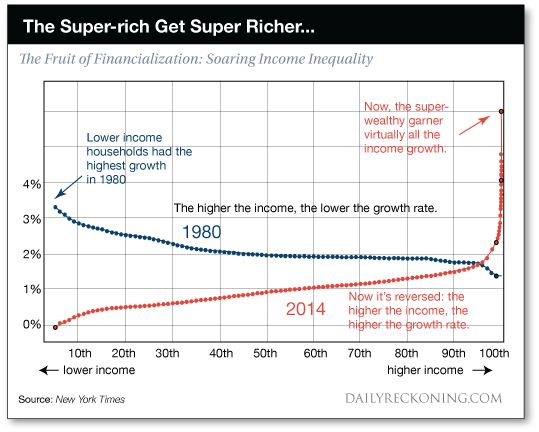This post The Fading Scent of the American Dream appeared first on Daily Reckoning.
This is the reality: the American Dream is now reserved for the top 0.5%, with some shreds falling to the top 5% who are tasked with generating a credible illusion of prosperity for the bottom 95%.
The question about who still has access to the American Dream is starkly answered by this disturbing chart:
If you talk to young people struggling to make ends meet and raise children, or read articles about retirees who can’t afford to retire, you can’t help but detect the fading scent of prosperity.
It has steadily been lost to stagnation, under-reported inflation and soaring inequality, a substitution of illusion for reality bolstered by the systemic corruption of authentic measures of prosperity and well-being.
In other words, the American-Dream idea that life should get easier and more prosperous as the natural course of progress is still embedded in our collective memory, even though the collective reality has changed.
For the bottom 95%, life is typically getting harder and less prosperous as the cost of living rises, wages are stagnant and the demands on workers increase.
Meanwhile, the asset bubbles inflated by central banks have enriched the top 10% of households, which own over 75% of all assets and take home over 50% of all household income.
The vast majority of household wealth is held by the top few households: the top .1% own roughly 25% of all US household wealth, the top 1% around 40%, and so on. So the households between 80% and and 95% own a very modest percentage of what the top 96%-99% own.
Median household income (using the Consumer Price Index measure of inflation, which grossly under-estimates real inflation) has gone nowhere since 2000. If income were adjusted by real inflation, it would show a 20% decline in purchasing power for all but the top 5%.
Clearly, our political-financial system and the policies of central banks have combined to concentrate wealth and income in the top of the wealth/income pyramid.
The average person knows the scent of the American Dream is fading, and many have lost hope of what was once taken for granted: home ownership, increasing income, and an easier life as household income and wealth slowly but surely increased with time.
But the collective memory of the American Dream remains; people feel they should be able to take a vacation, should be able to buy a starter home, should be free of constant worry about paying the bills, and so on.
With this collective memory still in place, people naturally start feeling a pervasive sense of betrayal: the system implicitly promised everyone who worked a lifetime security and increasing prosperity.
Official claims of prosperity are out of alignment with reality, and so expectations are out of alignment with reality. This creates a highly combustible and dangerous dynamic, as the emotions of betrayal and despair are volatile.
In other words, if 90% of the work force expects to be poor their entire lives, has no thought of …read more
Source:: Daily Reckoning feed
The post The Fading Scent of the American Dream appeared first on Junior Mining Analyst.

